
Deputy Leader of the Expert Group of the China Garment Intelligent Manufacturing Alliance
Expert of the Industrial Expert Committee of the China Garment Association
Professor of Donghua University, Wen Lisheng
I have described in the article “The Garment Manufacturing Industry Must Recognize AI Large Models and Their Applications” that the 2024 government work report of China proposed to carry out the “Artificial Intelligence +” initiative. I believe that with the arrival of the “Artificial Intelligence +” initiative, many “new species” under artificial intelligence technology will soon emerge, such as AI Agents, humanoid robots, self-driving cars, etc. These “new species” will soon be used for our own purposes, to accelerate the intelligent manufacturing of the manufacturing industry, and to promote the rapid development of China’s intelligent economy. Therefore, whether you are an enterprise or an employee within the enterprise, only by recognizing AI large models and having your own intelligent agent AI Agent can you enjoy its life services and gain survival opportunities in your profession in the future. So what is an intelligent agent AI Agent? Why do we need it?
When it comes to intelligent agents, we must mention the concept proposed by Professor Stuart Russell and Peter Norvig from the University of California, Berkeley, in their book “Artificial Intelligence: A Modern Approach (4th Edition)” published a few years ago. The book states that “anything that perceives the environment through sensors and acts on that environment through actuators can be viewed as an agent,” as shown in Figure 1.
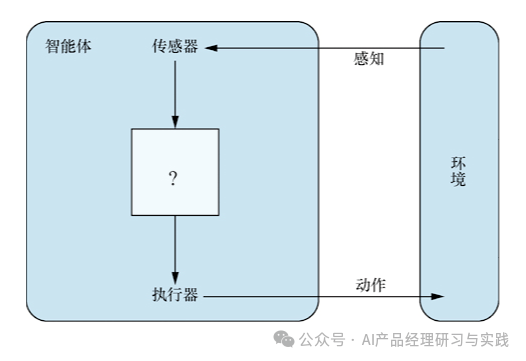
Figure 1: Concept of an Intelligent Agent
This concept of an intelligent agent is summarized from the continuous research and exploration of many researchers on intelligent agents and has now been widely applied in the fields of computer science and artificial intelligence, becoming an important part of the field of artificial intelligence.
Since the launch of ChatGPT last year, although it has powerful text generation capabilities, its limitations have gradually become apparent, such as: it can only conduct single-turn dialogues, lacks long-term memory and planning capabilities, cannot complete more complex tasks involving multi-step reasoning and tool invocation, and cannot autonomously solve problems. To overcome the limitations of ChatGPT, AI Agents have emerged.
The correct name for AI Agent is Artificial Intelligence Agent, which can also be referred to as an artificial intelligence assistant. It is an intelligent entity capable of perceiving the environment, making decisions, and executing actions. Unlike traditional artificial intelligence, it is a complex AI system that can achieve a complete process from perception to action through steps such as perceiving information, processing information, executing tasks, and outputting results. AI Agents aim to understand, analyze, and respond to human inputs, executing tasks, making decisions, and interacting with the environment like humans. They can be simple systems that follow predefined rules or complex, autonomous entities that learn and adapt based on experience.
OpenAI defines AI Agents as systems driven by large language models (LLM) that have the ability to autonomously understand perception, planning, memory, and tool usage, enabling them to automate the execution of complex tasks, as shown in Figure 2.

Figure 2: Definition of AI Agent
Similarly, Lilian Weng, the head of application development at OpenAI, has defined the framework for building AI Agents based on LLM. She pointed out that AI Agent = LLM (Large Language Model) + Memory + Planning Skills + Tool Use, where LLM serves as the brain of the agent, while memory, planning, and tool usage capabilities are key components. This definition has now become the classic definition of AI Agents in the era of large models, as shown in Figure 3.

Figure 3: Classic Definition of AI Agent Based on LLM
Recently, renowned AI scholar and Stanford University professor Andrew Ng gave a speech at the AI Ascent summit hosted by Sequoia Capital. He mainly introduced the workflow of AI Agents, stating that the workflow of AI Agents will drive significant progress in artificial intelligence in the future, potentially surpassing the next generation of AI foundational models. He called on everyone working in artificial intelligence to pay attention to the workflow of AI Agents. The four design patterns of AI Agent workflows he proposed include: (1) Reflection: Allowing AI models to self-check to improve code quality; (2) Tool Use: AI models using various tools to perform operations and gather information; (3) Planning: AI agents conducting complex planning algorithms, such as avoiding failures; (4) Multi-agent Collaboration: Different AI agents collaborating to complete tasks.
The four design patterns of AI Agent workflows proposed by Andrew Ng not only advance the practical application of AI Agents but also represent a significant step towards general artificial intelligence (AGI).
AI Agents can be classified into the following types:
1) By the complexity of AI Agents:
① Simple Reflex Agents: These agents follow condition-action rules and respond directly to current perceptions without relying on an internal model of the environment. They are simple and efficient but limited in their application scope due to their lack of adaptability to complex environments;
② Model-based Reflex Agents: Compared to simple reflex agents, these agents have an internal world model that can track and infer parts of the environment that cannot be directly perceived. They make decisions by combining current perceptions with the internal model, showing higher adaptability;
③ Goal-based Agents: These agents consider not only the current state but also the impact of actions on the future, possessing clear goals and making choices based on the probabilities of achieving those goals. They are suitable for complex decision-making tasks that require foresight;
④ Utility-based Agents: These agents use utility functions to evaluate different states and strive to maximize their performance. They are particularly useful in situations with multiple possible actions or outcomes, enabling optimal decision-making based on preferences;
⑤ Learning Agents: Learning agents can self-improve based on experience, enhancing their performance over time. They are especially effective in dynamic environments, gradually adapting and developing better strategies;
⑥ Multi-Agent Systems (MAS): In MAS, multiple agents work together to achieve common or individual goals. This system is suitable for complex tasks requiring coordination among multiple parties, such as supply chain management;
⑦ Hierarchical Agents: Hierarchical agents manage and guide tasks at different levels by establishing a hierarchical structure. Each level has specific responsibilities, working together to achieve overall goals. This structure is suitable for large systems that require management and execution of tasks at different levels.
2) By the form of AI Assistants:
① Data-based Intelligent Assistants: AI assists in internet data collection and analysis, market research, and provides interactive visual data analysis services;
② Office-based Intelligent Assistants: Provide automated functions such as knowledge retrieval and task execution based on natural language interaction, serving most high-frequency work scenarios for employees;
③ Generative Intelligent Assistants: Utilize AI for writing, drawing, editing, programming, etc., often used to assist employees in creative generation;
④ Marketing Intelligent Assistants: AI customer service/AI hosts can solve inquiries, marketing, and service issues based on natural language dialogue.
3) By the working mode of intelligent assistants:
AI Agents can be categorized into single AI Agents, multiple AI Agents, and hybrid AI Agents (human-machine interaction AI Agents), as shown in Figure 4: Single AI Agents focus on executing a single task or a series of related tasks without needing to interact with other agents. A single agent can perform different operations based on task execution, such as requirement analysis, project reading, code generation, etc.; Multiple AI Agents focus on interaction (cooperation or competition) and information sharing among agents, working collaboratively to complete more complex tasks or goals. The application scenarios for multiple AI agents are particularly helpful in highly collaborative work in software development, intelligent manufacturing, enterprise management, etc.; Hybrid AI Agents emphasize the importance and complementarity of human-machine collaboration in decision-making processes, working together to complete tasks.

Figure 4: Types of AI Agent Work(Source: AI Product Manager Study Practice)
According to reports from the Silicon Valley Technology Review (svtr.ai), in the past year, over 20 global AI Agent companies have received investment from well-known institutions. This includes Cognosys, invested by Google, Parcha AI, funded by Initialized Capital, and Sema4.ai, which received $30 million from Mayfield and Benchmark, dedicated to building intelligent agents to change the way knowledge workers collaborate with AI. In China, companies like Innovation Factory, Yunjiu Capital, and Yaotu Capital are also betting on AI Agent startups like Future Intelligence and New Dawn Intelligence.
2. Overview of Technologies Closely Related to AI Agents
1) Large Language Models (LLM) and AI Agents
Researchers believe that combining large language models (LLM) with AI Agents is an important step forward in artificial intelligence. These enhanced agents can now process information, interact with their environment, and execute multi-step operations, heralding a new era of task-solving capabilities.
According to the Digital Crowd public account, the workflow steps for combining large language models LLM with AI Agents are as follows, as shown in Figure 5: (1) The user raises a question; (2) The AI Agent packages the question and sends it to the LLM based on preset prompts; (3) The LLM returns results and necessary tools to the AI Agent; (4) The AI Agent uses the tools to gather necessary information; (5) The tools return the information to the AI Agent; (6) The context is packaged and sent back to the LLM; (7) The LLM returns results to the AI Agent, which gives the final result to the user.
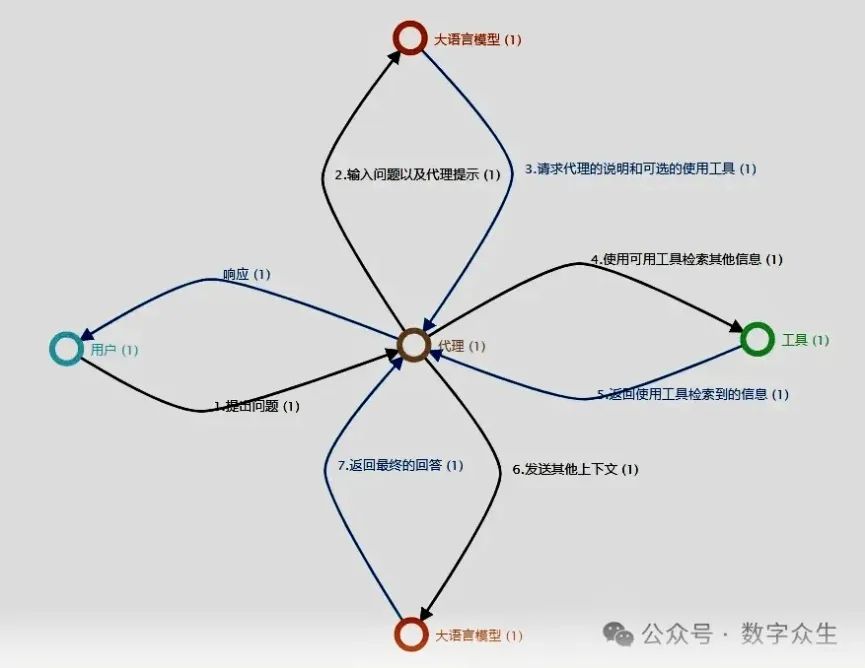
Figure 5: LLM Agent Business Workflow
2) Intelligent Agents and Robotic Process Automation (RPA)
RPA and AI Agents are two different technologies that play complementary roles in the manufacturing field. RPA technology utilizes software robots or “bots” to automatically execute repetitive business processes, aiming to simulate and integrate existing application operations, achieve automation, reduce manual intervention, and improve work efficiency. AI Agents, on the other hand, are intelligent entities capable of autonomous understanding, planning, decision-making, and executing complex tasks. They possess the ability to perceive the environment, make decisions, and execute actions, akin to human memory, logical analysis ability, task decomposition ability, and problem-solving ability. The main differences between the two lie in their problem-solving approaches:
① RPA is task-specific, while AI Agents have greater flexibility and autonomy.
② RPA focuses on executing rule-based human actions, while AI Agents can gradually achieve given goals through information perception and independent thinking.
In summary, while RPA and AI Agents are both important components of automation technology in the manufacturing field, they focus on different areas. RPA is more suited for handling highly repetitive and clearly defined tasks, while AI Agents are better suited for complex tasks requiring high cognitive abilities and autonomy. With technological advancements, the combined use of both will bring more possibilities and efficiency improvements to the automation field.
To elaborate on the differences between AI Agents, LLM, and RPA, refer to Table 1.
Table 1: Differences Between AI Agents, Large Language Models (LLM), and RPA

Source: AI Product Economics Study Practice Public Account
3) Intelligent Agents and Embodied AI
Embodied AI is a concept that emphasizes the close interaction between agents and their environments. It focuses on how agents understand and adapt to their environments through perception and interaction, making decisions and executing actions accordingly. Embodied AI emphasizes that agents must not only have the ability to process information but also the capability to interact with their environment in real-time. Such agents typically possess capabilities for perception, cognition, decision-making, and action, enabling them to interact with their environment through sensors and actuators and make corresponding decisions and actions based on environmental changes. The concept of embodied intelligence has broad applications in robotics, artificial intelligence, and cognitive science.
Intelligent agents, on the other hand, are software programs capable of simulating human thought and behavior, providing personalized and intelligent services to users. They are typically based on artificial intelligence technologies, analyzing user needs and behavior patterns, and utilizing big data, machine learning, and natural language processing technologies to assist users in information retrieval, task execution, decision support, and other operations. Intelligent agents can regularly collect information or perform services without human intervention, exhibiting high intelligence and autonomous learning capabilities. They can proactively gather the most interesting information for users based on user-defined criteria and utilize agent communication protocols to timely push processed information to users. Intelligent agents have wide applications in various fields, including personal life, business services, and professional services.
In summary, both involve the application of artificial intelligence technologies, but with different emphases. Embodied intelligence emphasizes real-time interaction and adaptability of agents to their environments, while intelligent agents focus on simulating human thought and behavior to provide personalized services. Additionally, embodied intelligence typically involves a combination of hardware and software, while intelligent agents are primarily software programs. In terms of application scenarios, embodied intelligence has broader applications in robotics and automation, while intelligent agents are more applied in information retrieval, task execution, and decision support.
3. Why Do We All Need AI Agents?
1) Because Humans and Intelligent Agents Need to Collaborate
As we enter the AI era, to enhance our knowledge and capabilities, everyone will have their own intelligent assistant AI Agent. With it, in the future, our work or services will only require us to set goals and provide necessary resources (such as computing power), allowing the AI Agent to independently undertake most of the work, while we only need to supervise and evaluate the final results of the AI Agent’s work. This work model fully reflects the collaboration, interactivity, autonomy, and adaptability between humans and intelligent agents, as shown in Figure 6.
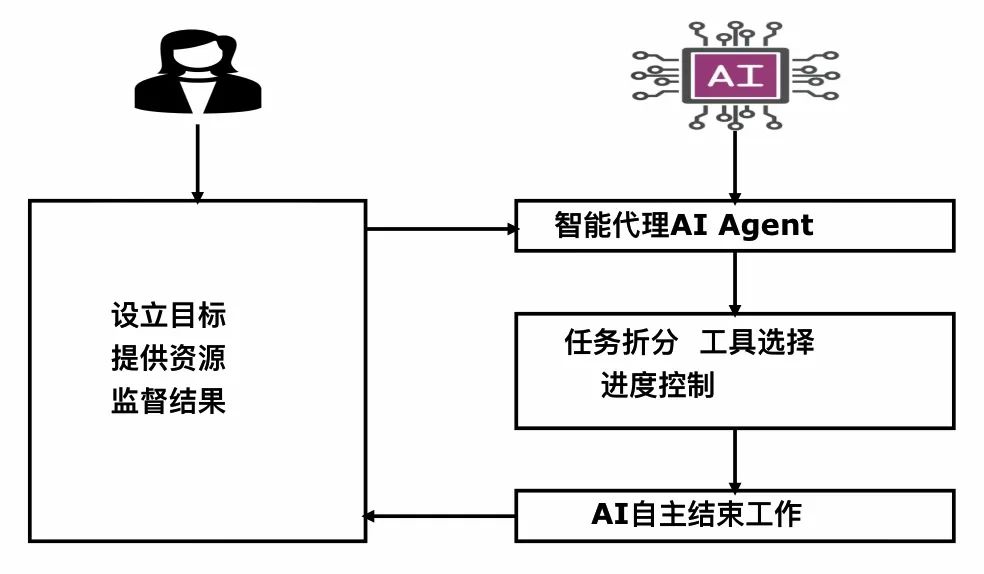
Figure 6: Collaboration Between Humans and AI Agents
2) Because Humans Can Only Solve Problems in the Garment Manufacturing Industry by Utilizing Different Forms of Architecture Composed of Single and Multiple Intelligent Agents
As we know, a multi-single intelligent agent architecture is driven by a language model and independently executes all reasoning, planning, and tool execution tasks. The multi-agent architecture involves two or more agents, each of which can use the same language model or a set of different language models. Agents can access the same or different tools. Each agent typically has its own role and task. Multi-agent architecture can have various organizations at any level of complexity. They are usually divided into vertical intelligent agent architectures and horizontal intelligent agent architectures: in vertical architecture intelligent agents, one agent acts as a leader, and there is a clear division of labor among the collaborative intelligent agents, who report directly to the leader; in horizontal architecture intelligent agents, all agents are regarded as equals and are part of a group discussion about the task. Communication among agents occurs in a shared thread, where each agent can see all messages from other agents. Agents can also voluntarily complete specific tasks or call tools, meaning they do not need to be assigned by the leading intelligent agent. Horizontal architecture is often used in tasks that require cooperation, feedback, and group discussions to successfully complete tasks, as shown in Figure 7. Thus, in the application of garment manufacturing, a single intelligent agent system can handle static and simple tasks, while multiple intelligent agent systems are better suited to dynamic and complex tasks. The diversity and self-organization capabilities of multiple intelligent agent systems enable them to adapt to various environments and needs, providing broader solutions and more application options. This difference allows both systems to leverage their unique advantages in different application scenarios.

Figure 7: Single vs. Multiple Intelligent Agent Architectures
3) Because the Future Work of Garment Manufacturing Enterprises Will Be Completed by Virtual Employee AI Agent Intelligent Agents Collaborating with Humans
In the garment manufacturing industry, artificial intelligence agents can be viewed as virtual digital employees, as AI Agents possess powerful reasoning and multi-modal capabilities that enable human-machine collaboration, equipping each employee with an all-scenario, 24-hour uninterrupted intelligent assistant. At this stage, digital employees will be able to comprehensively cover existing business scenarios and automate all complex business processes. The application of AI Agents covers the entire chain of garment manufacturing: in the research and design field, large models enhance research and development efficiency by optimizing design processes; in production and manufacturing, large models expand the boundaries of intelligent manufacturing applications; in management, large models improve management levels based on assistant models; in product service, large models promote product and service intelligence through interactive capabilities, as shown in Figure 8.
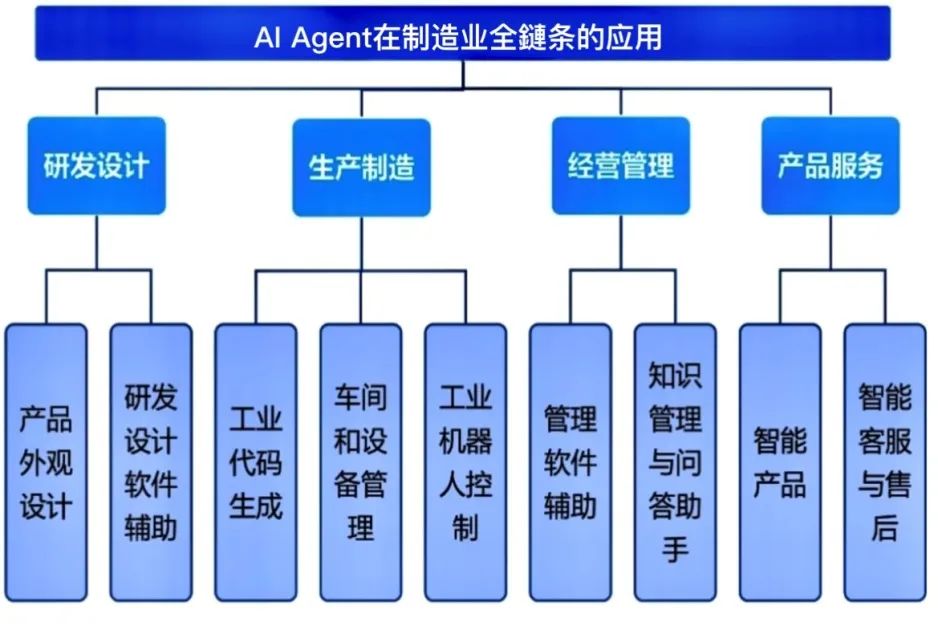
Figure 8: Application of AI Agents in All Stages of Garment Manufacturing
In garment manufacturing enterprises, the collaboration between virtual employee AI Agent intelligent agents and humans can be reflected in the following aspects: (1) AI Agents can provide real-time operation guidance and support for workers through speech recognition and natural language processing technologies; (2) AI Agents can analyze customer data, providing personalized customer service and product recommendations, enhancing customer satisfaction; (3) AI Agents can assist engineers in product design, offering innovative design solutions and shortening product development cycles; (4) AI Agents can analyze production data for employees, optimizing production processes and improving production efficiency and resource utilization; (5) AI Agents can optimize process parameters by analyzing data during production processes, enhancing product quality and production efficiency; (6) AI Agents can control industrial robots to execute precise operations, assembly, transportation, and handling tasks, improving production efficiency and safety; (7) By analyzing market trends and historical data, AI Agents can predict product demand, optimizing inventory levels and reducing inventory costs; (8) AI Agents can monitor and analyze energy usage, proposing energy-saving measures to reduce energy costs; (9) Utilizing computer vision technology, AI Agents can help humans automatically detect defects in finished garments, ensuring product quality, etc.
4) Because Developing AI Agents Is Generally Difficult for Ordinary Garment Manufacturing Enterprises and Employees, They Typically Use AI Agent Platform Services to Obtain Them
When manufacturing enterprises decide whether to develop AI Agent services themselves or use platform services, they need to consider multiple factors. First, from a cost perspective, developing AI Agent services in-house may require substantial investments in labor, materials, and time, including technology development, data collection, model training, etc. Using platform services can reduce these costs, as the platform provider has already completed the foundational work, allowing manufacturing enterprises to integrate and customize according to the interfaces and specifications provided by the platform. Second, regarding technical and talent reserves, manufacturing enterprises may lack specialized talent and technical accumulation in the AI field, and developing AI Agent services in-house may face technical challenges and talent bottlenecks. Using platform services can leverage the technological and talent advantages of the platform provider, quickly achieving intelligent upgrades and transformations. Additionally, data security and privacy protection issues must be considered. Developing AI Agent services in-house allows for better control over data security and privacy protection but requires more effort and resources to ensure this. Using platform services necessitates ensuring that the platform provider can offer sufficient data security measures and requires careful reading and understanding of the platform’s data usage policies and privacy protection clauses. In summary, from the perspective of market trends and future development, for ordinary manufacturing enterprises, utilizing platform services may be a faster, more convenient, and economical choice, enabling quicker intelligent upgrades and transformations.
There are numerous AI Agent service platforms in China, such as Alibaba, Tencent, Baidu, JD.com, Huawei Cloud, Baichuan Intelligent, Lianhui Technology, Lanma Technology, iFlytek, SenseTime, ChatDev (jointly researched by Tsinghua University, Beijing University of Posts and Telecommunications, and Brown University), Sobot, ByteDance, KuanShi Robotics, DeepBlue Technology (Shanghai), 360 Group, CloudWalk Technology, Zhiyu AI, etc. Among them, Alibaba Group’s DingTalk intelligent mobile office platform has been dedicated to providing efficient and intelligent office solutions for enterprises. In the AI Agent field, DingTalk has launched innovative products like intelligent assistants, leveraging its deep accumulation in artificial intelligence and big data to provide smarter and more personalized services for enterprises. On April 19, 2024, DingTalk officially launched the AI Assistant market, marking a further deepening of DingTalk’s comprehensive intelligent strategy, planning to launch over 200 AI assistants in the first batch and aiming to introduce ten thousand AI assistants in the near future. This not only represents a large number but also covers multiple fields such as enterprise services, industry applications, efficiency tools, finance, law, education, entertainment, etc., bringing users an unprecedented intelligent experience. The functions of the DingTalk AI Assistant service platform are shown in Figure 9, available for both enterprises and employees.
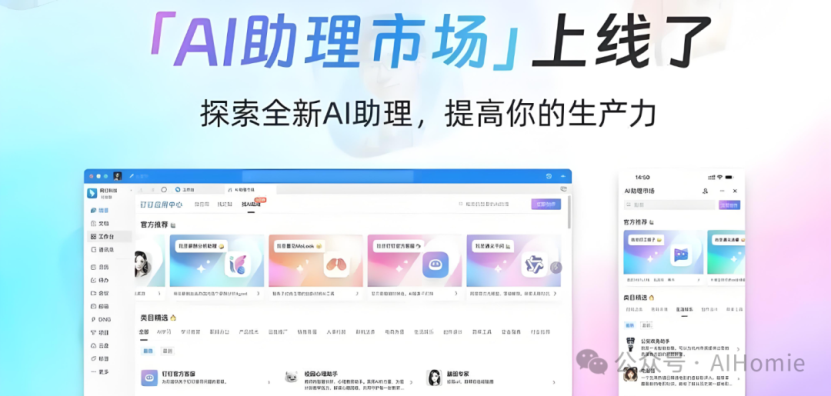
Figure 9: DingTalk AI Agent Service Platform
1) We must be prepared for the fact that as the autonomy of AI Agents further strengthens, AI Agents will evolve into more specialized agents, replacing most professional and skilled work in the manufacturing industry. From a trend perspective, the arrival of large model agents replacing 90% of human professional work is imminent; in the near future, AI Agents will integrate with more hardware products (not limited to embodied intelligence and humanoid robots), potentially completely replacing human jobs. Therefore, whether as enterprises or individuals, in this new era, we must learn new knowledge and master new skills to cope with the challenges and opportunities brought by AI Agents.
2) The core features of intelligent agents AI Agents are their autonomy, which allows them to make decisions based on environmental changes and task requirements; their learning capabilities enable them to continuously optimize behavior strategies based on experience, enhancing adaptability and problem-solving abilities; and their environmental adaptability ensures that they can operate efficiently in various complex and uncertain environments. These characteristics make AI Agents indispensable independent decision-making units within complex systems. Multi-agent systems consist of multiple agents that form a group intelligence unit capable of sharing information, coordinating actions, and jointly achieving goals through clear role division, flexible organizational structures, and efficient interaction mechanisms.
3) Currently, research on AI Agent systems still faces some challenges and limitations. Inconsistencies in evaluation standards, adaptability to real-world application scenarios, and inherent biases in language models are key issues needing focus in current research. Future research may concentrate on establishing a more comprehensive and objective evaluation system, enhancing the reliability and robustness of AI Agent systems in real-world scenarios, and exploring effective methods to reduce system biases. Although current AI Agent systems are not fully mature, their capabilities in reasoning, planning, and tool usage have already surpassed traditional static language models. With continuous technological advancements, AI Agents are expected to play a critical role in more fields, becoming a key link in promoting the development of AI applications.
4) With the development of deep learning, reinforcement learning, and other technologies, the capabilities of agents will be further enhanced, with more powerful perception, decision-making, and learning abilities. This will enable them to execute tasks in more complex environments, even surpassing human capabilities in certain aspects. Additionally, the application domains of agents will further expand, especially in manufacturing sectors that require high levels of automation and intelligence, where agents will become indispensable tools. Finally, the social impact of agents may be even more profound, potentially changing our working, living, and thinking patterns. At the same time, this will raise a series of social, ethical, and legal issues that require in-depth research and discussion. Nevertheless, I strongly agree with Bill Gates, who recently stated in an article: “In five years, AI Agents will be widespread, and every user will have their own dedicated AI Agent.”
Drafted in Shanghai, June 2024











